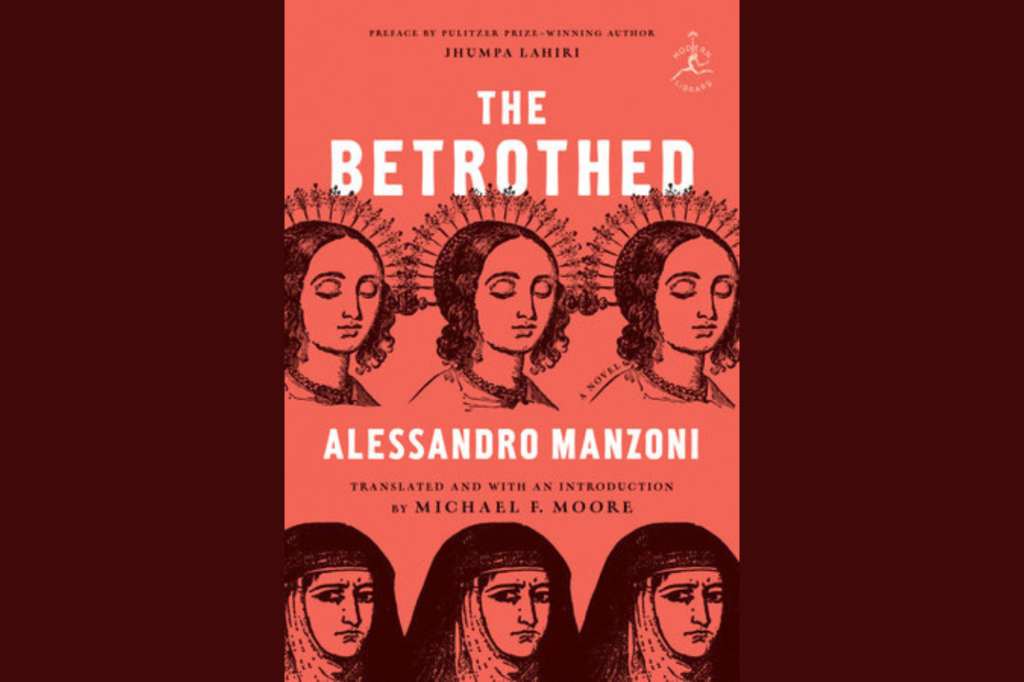To read a nearly 700-page novel is a commitment. Imagine the dedication needed to translate such an epic. Only a masterpiece deserves such perseverance, and Alessandro Manzoni’s 1827 Italian novel The Betrothed ranks among the greatest classics, to be shelved alongside Les Miserables, War and Peace, and Moby Dick. The 2022 translation by Michael F. Moore required a decade of work, not to mention an additional revision needed in light of the passages about the Great Plague of Milan (1629-1631) sounding so relevant to the recent 2020 epidemic.
While many mentors and friends had recommended this novel to me over the years, I could never get into it, in large part because of the inaccessible translations that preceded this one. Jhumpa Lahiri laments likewise in her preface to this edition. Of a previous version, Lahiri writes, “I found the translation underwhelming and nearly as impenetrable. I read a few chapters before abandoning it.” However, this new translation by Michael F. Moore finally gives English readers access to one of the most beautiful novels in the world.
Not knowing much about Manzoni, I was delighted to hear of his powerful conversion story in the introduction. Moore explains how this writer, having absorbed the philosophy and art of Romanticism, then turned to the Catholic faith at an unexpected moment in his life. In 1810 in Paris, Manzoni and his wife were celebrating the marriage of Napoleon to Marie-Louise “when firecrackers went off, creating pandemonium” and causing crowds to panic and disperse. Separated from his wife, Manzoni found refuge in a church where he vowed to convert if the Lord brought her to him again. She discovered him on the steps of the church, and the two became Catholics together.
Moore does not merely relate this anecdote as an interesting episode in Manzoni’s life, but rather as the explanation behind the spiritual fervor of The Betrothed. “Manzoni’s conversion marks a turning point in his thinking and his writing,” Moore observes. One cannot read The Betrothed as though faith is merely the backdrop of the seventeenth-century. The catalyst for the problems for this young, engaged couple (the “betrothed” Renzo and Lucia) is the lack of faith by their local parish priest, Don Abbondio (whose name ironically means abundance), who refuses to marry the lovers when he is threatened by the bravi (think seventeenth-century thugs) on behalf of the lustful Don Rodrigo. The worldly powers, such as the government and lawyers, protect the interests of that wealthy nobleman, and thus this faithful but poor couple is left vulnerable.
Start your day with Public Discourse
Sign up and get our daily essays sent straight to your inbox.The novel often asks the reader, an implicit echo, how do you live as a faithful Christian when so much evil persists in the world?
Like the most divine of comedies, The Betrothed seeks to end in marriage. The hurdles to this union are not the trivial misunderstandings that pervade rom-com films but the world, in its theological sense. The betrothed’s pilgrimages are separate threads, as both Renzo and Lucia attempt to do the Lord’s will. It is no mere piety that drives our protagonists to prayer: Renzo wrestles with making his own decisions versus submitting to the will of God, and Lucia struggles between her devotion to her betrothed and her love for God and the Virgin Mary. They seek the wisdom and aid of a holy man Fra Cristoforo (“one who bears Christ”), whose story resembles the hagiography of Fr. Zosima from The Brothers Karamazov. Like Zosima, Cristoforo was once a wayward noble who commits egregious sin and turns to the life of a monk.
Regularly the world is pitted against the sanctity of a few in The Betrothed. The novel often asks the reader, an implicit echo, how do you live as a faithful Christian when so much evil persists in the world? Never does the novel settle for easy dichotomies between good and evil. For instance, Lucia’s mother Agnese gives as much awful advice as she performs charitable deeds to help the betrothed. Although the priest Don Abbondio is worthless—his self-centered rants sound a lot like the “woe is me” from the worst characters in Jane Austen—Archbishop Federigo emits holiness like incense. His interactions with others in the text bring Jesus back to life, and in one of the most moving episodes in the novel, the priest receives the confession of the villain who is so evil he is called “the Nameless One,” like a seventeenth-century Voldemort. We witness real treachery in Don Rodrigo and his cronies, but also real heroism in the betrothed and those who support them.
More than anything, The Betrothed shows us the reality of forgiveness and the possibility of fulfilling Jesus’s most challenging commandment: love your enemies. In the gospel of Luke (6:27-28), Jesus preaches, “Love your enemies, do good to those who hate you, bless those who curse you, pray for those who mistreat you.” When Lucia is kidnapped, she prays over her torturer. And he repents! It’s miraculous and strange and written in such a convincing way that no reader can sentimentalize the conversion. When Renzo plots revenge on Don Rodrigo, he finds the former villain lying on a bed of straw, black lesions from the plague covering his dying flesh, and Renzo prays over the very man who has caused the last year and a half of pain for him. The providence of God overrides the plans of both the good and the wicked in this novel to remind readers that his ways are not the same as those of human beings. A higher way scandalizes the reader from complacency to wonder, even to reverence.
More than anything, The Betrothed shows us the reality of forgiveness and the possibility of fulfilling Jesus’s most challenging commandment: love your enemies.
Michael F. Moore has argued that The Betrothed is a history of seventeenth-century Italy written as a novel. Like its classic counterparts, already mentioned—Les Miserables and War and Peace—The Betrothed sets the drama of these dynamic characters against an ever-changing backdrop of historical saga. In the tale’s beginning, we share with Renzo the difficulty of the famine facing the poor; he starves for bread and, thanks to a series of unlikely and unfortunate circumstances, unintentionally participates in a revolt. This lack of bread stemmed from the Thirty Years’ War, which rears its violent head in the siege of Casale Monferrato (March 1628–April 1629), which is in the regions and time where the story of The Betrothed is set. Although somewhat off-stage, the incoming soldiers and other bandits disrupt the homes of the characters in Lecco, such as Don Abbondio, his maid Perpetua, and Agnese. The novel records not only the famine and war but also the plague that struck the area from 1628 to 1630. Within the story, the plague becomes the great equalizer, dethroning the wealthy and showing all people as mortals who must face their death and judgment.
Although written in the nineteenth century, The Betrothed poses as a retelling of a seventeenth-century manuscript, recording a true story that occurred during this historical period. The novel becomes an emblem of Italian identity, the first work of such magnitude in the Italian language. Now in a beautiful translation for English readers, the novel compels us to answer questions about how to be virtuous in our own time and place. We have journeyed with the betrothed, their enemies, their family. We have experienced their hunger, their battles, and an uncontainable pandemic. How then should we live in the face of our own crises?
The Betrothed is neither a memoir nor a realistic narrative, but an epic comedy that invites us into a larger cosmos. On its pages, we can rage at injustice, repent of our guilt and complicity with the cowardly, but hopefully also display our courage in perseverance.














